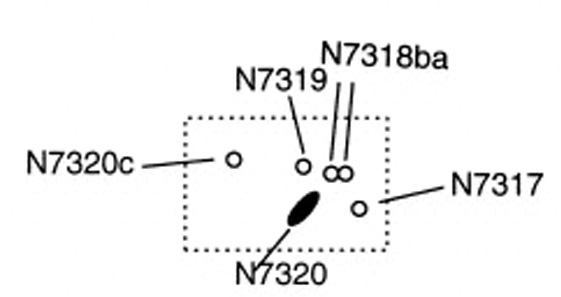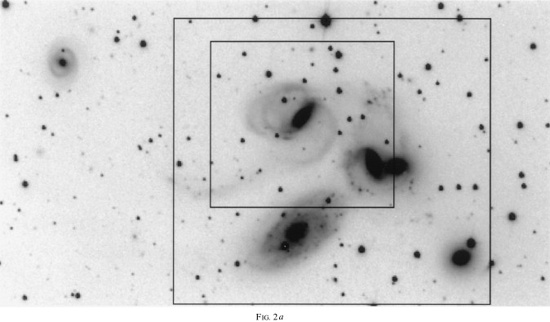

This small group of spiral galaxies was first discovered by the French astronomer, Edouard Stephan in 1877 and is often considered the prototype of small compact galactic groups. It is the first of the compact groups found and probably the most investigated at all wavelengths. Initially Stephan included five relatively bright members (NGC 7317, 7318A/B, 7319, and 7320). In 1961 red shift measurements of the group revealed that NGC7320, the largest member of the group, had a discordant redshift and is receding at a velocity 5000 kilometers per second slower than the other four members. A redshift is considered discordant if it differs from the median redshift of the group by more than 1000 kilometers per second. Although the case of NGC 7320 still fuels controversy it is generally agreed that all members of the group are gravitationally interacting with the exception of the interloper NGC 7320 which is a foreground galaxy. Supporting this view is the observation that clear signs of gravitational interaction are visible among the other members including distortion of spiral arms and long tidal tails and filaments, with the exception of NGC 7320. A fifth galaxy, NGC 7320A is most likely a true member of the group having a concordant redshift with the other true members. It is likely that the true members lie at a distance of 260 million light years while NGC 7320 is much closer in the foreground at a distance of 50 to 100 million light years and may be physically interacting with the nearby galaxy NGC 7331.
A best guess dynamical history of SQ goes as follows. Stephan's Quintet is composed of a kernal of three galaxies (NGC 7317, 7318A, and 7319) that has sufficient mass to attract nearby galaxies into high velocity encounters. A luminous halo surrounds the triplet kernel indicating it is a dynamically evolved somewhat stable aggregate system with a true physical relationship. The triplet has probably formed over the last 2 billion years starting with tidal flows and more recently with merging of halo structures. A fourth member NGC 7320C was probably captured within the last one billion years but is only loosely bound to the system at present. NGC 7318B is almost certainly entering the group for the first time in the form of a high velocity collision with NGC 7318A. The interloper NGC 7230 lies at a similar redshift to the nearby galaxy NGC 7331 and is most likely physically related to that system. If this history is correct it suggests that compact groups may get their start as tightly bound subsystems or kernels, with later interactions with loosely bound, or even unbound, populations of infalling neighbor galaxies. Possibly a common scenerio for compact groups would involve a triplet or quartet kernel acting as a seed, gravitationally attracting intruders into collisions and subsequent mergers with the group.
Membership among compact groups of galaxies is an ongoing controversy among astronomers. Interlopers having discordant redshifts occur with unexpected frequency of 43% among compact groups creating an intriguing problem that has so far eluded an explanation. Although redshift evidence is felt to be reliable confirmation of membership other theories have come forth to explain the apparent proximity of compact groups. One explanation is that many of the compact groups may actually be looser groupings aligned along filaments of larger clusters creating an appearance of proximity along our line of site. More detailed studies should provide answers to these questions.
Red shift measurements are though to be an indirect but reliable method of establishing distances of galaxies. The premise of the method lies in the "Hubble Law" which states that due to the general expansion of the universe, the velocity at which a galaxy is receding is proportional to the distance of that galaxy from us. Galaxies having the same redshift are thought to reside at the same distance from earth.

